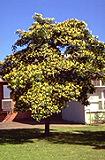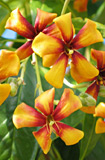
Native Frangipani - Hymenosporum flavum
Ivan Holliday
Although of sub-tropical origin, native frangipani is one of the best small to medium sized, long-flowering trees which is grown successfully in most areas of the Adelaide region. Here, winters are cool to cold and reasonably wet (annual
rainfall approx. 500-600 mm, most of which falls in winter), but usually, very dry from October to June. Summer periods can be extremely hot, in excess of 40oC.
Large areas of Adelaide soils are red-brown earth (lime-based and alkaline to neutral clays), which become very dry in summer and autumn. Yet native frangipani succeeds in streets where the trees receive no water other than natural rainfall, or perhaps, some additional moisture from adjacent private gardens. I have also observed this tree growing successfully on Yorke Peninsula on very limey soils, and where rainfall is only about two thirds of that in Adelaide.
 |
 |
|
| A native frangipani tree (left) and a selected form having flowers with a deep red centre (right). Photos: Brian Walters; Peter Vaughan |
|
Native frangipani is the only Australian species of Hymenosporum, and is closely related to the Pittosporum genus, which it resembles in certain respects. It is native to the coastal brush forests of eastern Australia, extending from the Hunter River in New South Wales to Atherton in Queensland.
In tropical Queensland some trees grow to 25 metres with a stem diameter of 30 cm or more, but further south it is much smaller. In cultivation it is usually only a small, very slender and upright tree up to 10 m high. Bark is grey and roughish, and the branches are sparse, radiating in whorls from the main stem. The deep lustrous green leaves, which resemble those of Pittosporum, are alternately grouped at the ends of the twiggy branchlets, oval-oblong in shape, and 7-15 cm long. This is a very fine flowering tree that begins to bloom in early spring, when the fragrant, open, tubular flowers are cream-coloured. They darken with age to a deep sulphur yellow before they drop. The effect of masses of cream and yellow flowers is very lovely. The flowering period extends to early summer. The 4 cm diameter flowers in terminal corymbs are sweetly scented, and about the size and shape of those of the frangipani, from which the common name is derived. In other respects the tree bears no resemblance.
Fruit capsules are hard and brown, containing numerous closely packed layers of brown, papery seeds which germinate freely.
From 'Australian Plants', the quarterly journal of the Association of Societies for Growing Australian Plants , June 1998.
Australian Plants online - 2006
Association of Societies for Growing Australian Plants
|